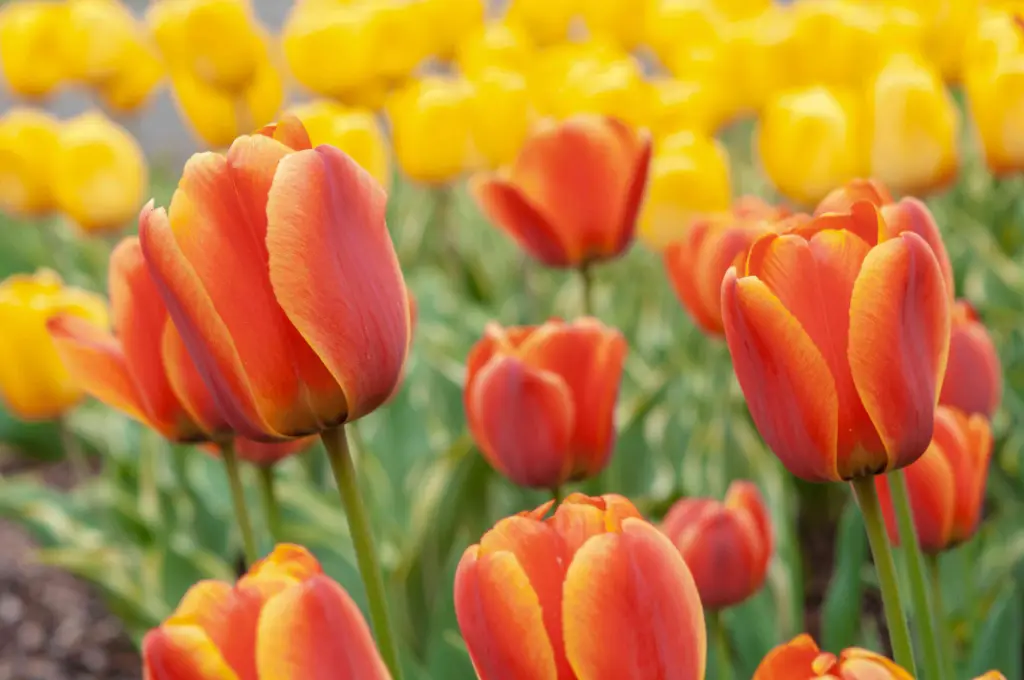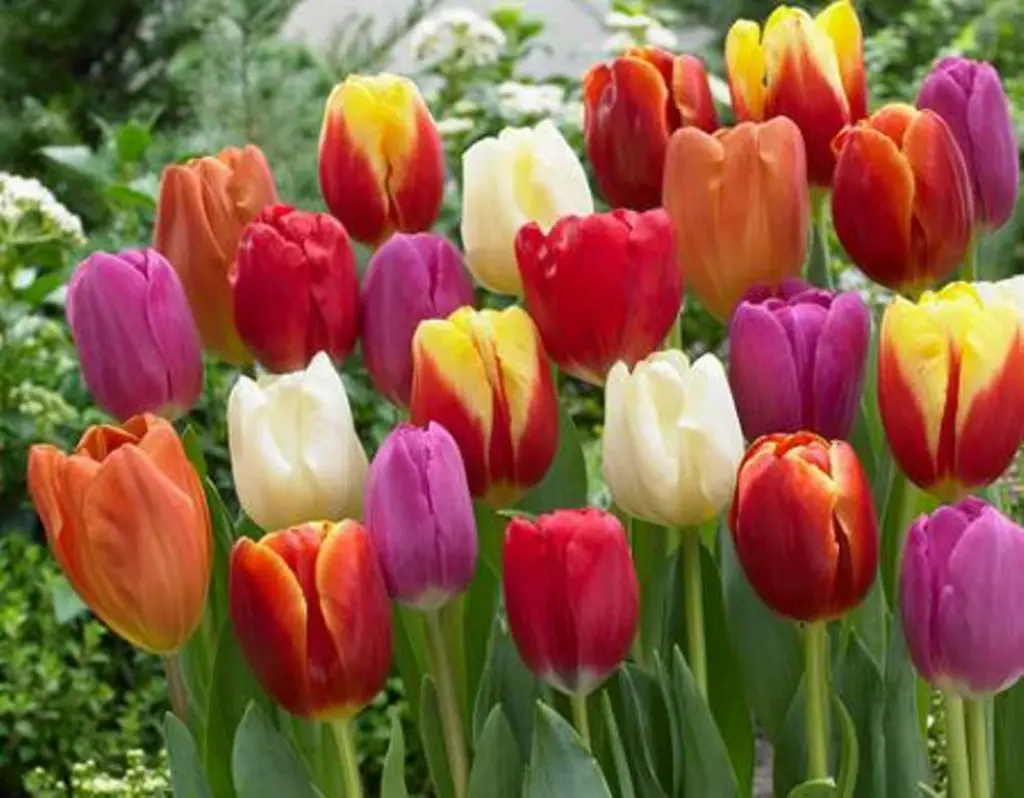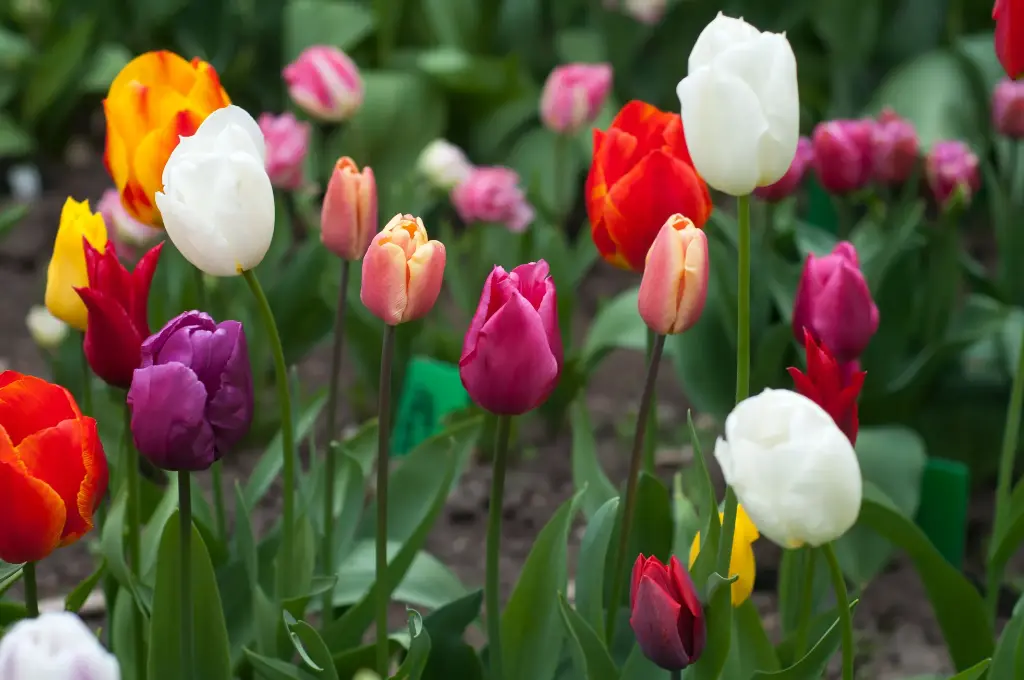Tulips are one of the most beloved spring flowers, known for their vibrant colors and elegant shapes. Whether you’re a seasoned gardener or a novice, growing tulips can be a rewarding experience. In this comprehensive guide, we’ll cover everything you need to know about growing tulips, from planting bulbs to selecting varieties. We’ll also provide a helpful seasonal guide to ensure your tulips thrive.
Introduction to Tulips
A Brief History of Tulips
Tulips have a rich history that dates back to the Ottoman Empire, where they were cultivated and prized for their beauty. They were introduced to Europe in the 16th century and quickly became a symbol of wealth and status, particularly during the infamous «Tulip Mania» in the Netherlands.
Why Grow Tulips?

Tulips are not only beautiful but also relatively easy to grow. They come in a wide range of colors and shapes, making them a versatile choice for any garden. Additionally, tulips are hardy and can thrive in various climates, provided they receive the right care.
Choosing the Right Tulip Varieties
Popular Tulip Varieties
There are over 3,000 registered varieties of tulips, categorized into 15 groups based on their flower shape, size, and blooming time. Some popular varieties include:
- Single Early Tulips: These tulips bloom early in the spring and have simple, cup-shaped flowers.
- Double Late Tulips: Known for their peony-like blooms, these tulips flower later in the season.
- Parrot Tulips: With ruffled petals and vibrant colors, these tulips add a dramatic flair to gardens.
- Triumph Tulips: A cross between Single Early and Darwin Hybrid tulips, these are known for their sturdy stems and variety of colors.




Selecting Tulips for Your Garden
When choosing tulip varieties, consider factors such as bloom time, color, and height. Mixing different varieties can extend the blooming season and create a more dynamic display. Also, consider the climate and soil conditions in your garden to ensure the varieties you choose will thrive.
Preparing Your Garden
Soil Requirements
Tulips prefer well-draining soil with a pH level between 6.0 and 7.0. Amend heavy clay soils with organic matter such as compost or peat moss to improve drainage. Sandy soils, on the other hand, may require additional nutrients to support healthy growth.
Sunlight and Planting Location
Choose a location that receives full sun for at least six hours a day. Tulips can tolerate partial shade, but they will produce fewer blooms. Ensure the planting site is protected from strong winds, which can damage the tall stems and delicate flowers.
Planting Tulip Bulbs

When to Plant Tulip Bulbs
The best time to plant tulip bulbs is in the fall, about 6 to 8 weeks before the first hard frost. This allows the bulbs to establish roots before the ground freezes.
How to Plant Tulip Bulbs
Follow these steps to plant tulip bulbs successfully:
- Digging the Hole: Dig a hole about 6 to 8 inches deep, ensuring the soil is loose and well-drained.
- Spacing the Bulbs: Place the bulbs in the hole with the pointed end facing up. Space them about 4 to 6 inches apart.
- Covering the Bulbs: Cover the bulbs with soil, pressing down gently to remove air pockets.
- Watering: Water the bulbs thoroughly after planting to help them settle and start the rooting process.
Seasonal Guide to Tulip Care
Here’s a handy seasonal guide to help you manage your tulip care throughout the year:
| Jan | Feb | Mar | Apr | May | Jun | Jul | Aug | Sep | Oct | Nov | Dec | |
|---|---|---|---|---|---|---|---|---|---|---|---|---|
| Plant | yes | yes | yes | |||||||||
| Flowers | yes | yes | yes | |||||||||
| Cut back | yes | yes |
Seasonal Care and Maintenance
Spring Care
As tulips emerge in the spring, provide them with a balanced fertilizer to support their growth. Water them regularly, especially during dry spells, but avoid overwatering, which can lead to bulb rot.
Summer Care
Once the tulips have finished blooming, allow the foliage to die back naturally. This process helps the bulbs store energy for the next season. You can cut back the foliage once it has turned yellow and dry.
Fall and Winter Care
In the fall, apply a layer of mulch over the planting area to protect the bulbs from extreme cold. If you live in an area with mild winters, you may not need to mulch, but it’s a good practice to ensure the bulbs are insulated.
Common Problems and Solutions
Pests and Diseases
Tulips can be affected by various pests and diseases, including:
- Aphids: These small insects can damage tulip leaves and spread diseases. Use insecticidal soap or neem oil to control aphid infestations.
- Botrytis Blight: Also known as tulip fire, this fungal disease causes brown spots and distorted growth. Remove and destroy infected plants to prevent the spread.
- Bulb Rot: Overwatering or poor drainage can lead to bulb rot. Ensure proper planting depth and soil conditions to avoid this issue.
Environmental Challenges
Tulips may also face environmental challenges such as:
- Late Frosts: Late spring frosts can damage emerging tulips. Protect them with frost cloths or coverings during cold snaps.
- Poor Blooming: If tulips fail to bloom, it may be due to inadequate sunlight, poor soil conditions, or overcrowding. Ensure they receive enough light and nutrients, and divide overcrowded bulbs.
Enjoying Your Tulips

Cutting Tulips for Arrangements
Tulips make beautiful cut flowers. To enjoy them indoors, cut the stems at an angle early in the morning when the buds are just starting to open. Place them in a vase with fresh water and change the water every few days to prolong their vase life.
Landscaping with Tulips
Tulips can enhance your garden’s aesthetic appeal. Consider planting them in clusters or drifts for a more natural look. They also pair well with other spring-blooming bulbs and perennials, such as daffodils, hyacinths, and primroses.
Saving and Storing Bulbs
After the growing season, you can save and store tulip bulbs for replanting. Dig up the bulbs once the foliage has died back, clean off any soil, and allow them to dry in a cool, dark place. Store the bulbs in a mesh bag or paper sack until the next planting season.

Growing tulips is a rewarding endeavor that brings vibrant colors and beauty to your garden. By selecting the right varieties, preparing your garden, and following proper planting and care practices, you can enjoy a stunning display of tulips year after year. Remember to adapt your care routine based on seasonal needs and be proactive in addressing any problems that arise. With a little effort and attention, your tulips will thrive, adding a touch of elegance and charm to your outdoor space.
Tulips are more than just flowers; they are a symbol of spring’s arrival and a testament to the beauty of nature. Happy gardening!



